Let’s face it; everyone loves beautiful animals no matter what shape or size they come in.
But what one species differs from another is its own unique traits.
Some might be able to maximize their ability to move or adapt in different terrains and climates while others possess a very distinctive physical trait that separates them from the rest of their family.
But the thing that really catches our human eyes is their color.
Even in nature, the two most common colors we find are green and blue. The forest, trees, and almost every living plant on this earth is green while the sky and seas are mostly blue.
Blue symbolizes serenity as well as beauty. But there also blue animals that are hidden from the eyes of the world.
This blue coloration comes from the pigment in their skin cells or reflective and iridescent properties on their body that contribute to this amazing phenomenon.
If you still don’t believe that blue animals exist, here are 25 beautiful blue animals that will blow your mind with their beauty:
Table of Contents
1. Blue Poison Dart Frog
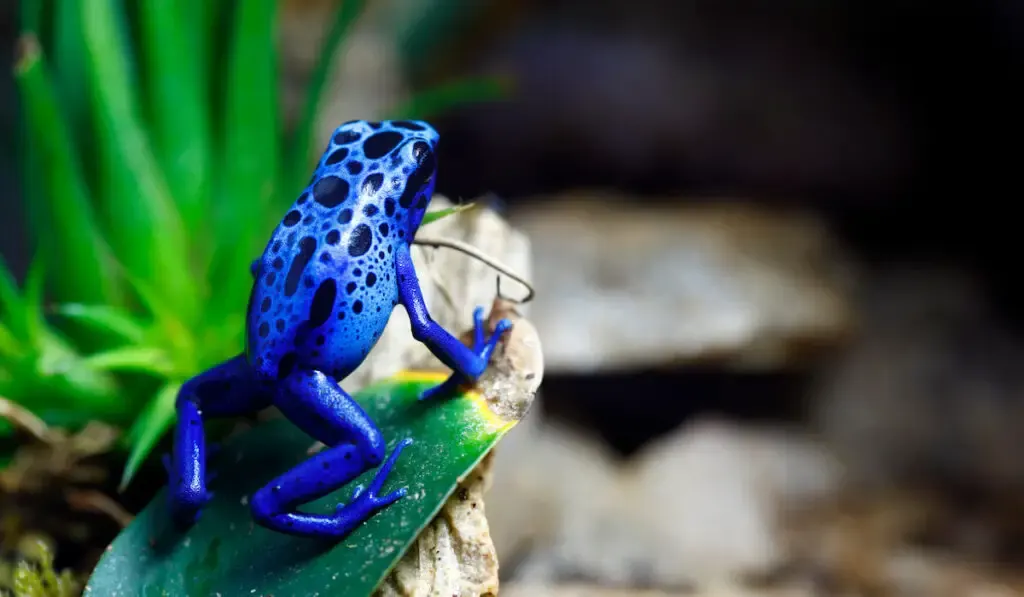
Discovered in 1969, these small frogs can only be found in secluded areas of rainforest in Surinam, South America, and Northern Brazil.
The size of their body is between 1 to 1.5 inches and weighs around 0.02 pounds.
Do not be fooled by the beauty of their bright blue skin color. It is a sign of danger to cast predators away from them. Their glossy blue skin contains toxins that will paralyze or kill any potential predators.
They don’t produce the toxins by themselves but by consuming highly poisonous ants in their habitats.
Blue Poison Dart frogs are considered diurnal, which means that they are highly active during daylight. They usually breed in February and March and the female frogs lay between five and ten eggs at a time.
2. Blue Whale
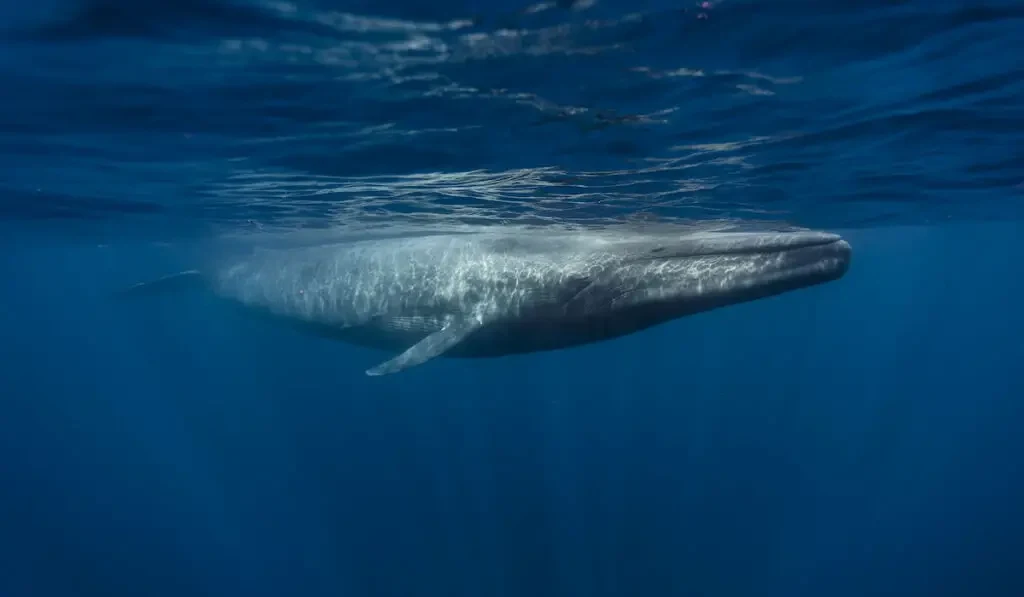
The Blue Whale is the largest animal on this planet with a length of 110 feet and weight up to 330,000 pounds.
Blue whales have a large, long, mottled blue-gray body and can be found in every ocean except the icy parts of Arctic oceans.
Although they are the largest animals, they aren’t considered predators.
This is because their diet mostly consists of krill (which is a tiny shrimp-like animal). They eat around 6 tons of krill per day.
As mammals, female blue whales give birth to extremely large calves and nurse them for about six months.
Blue whales are considered as endangered species and are protected under the Marine Mammal Protection Act.
3. Chesapeake Blue Crab
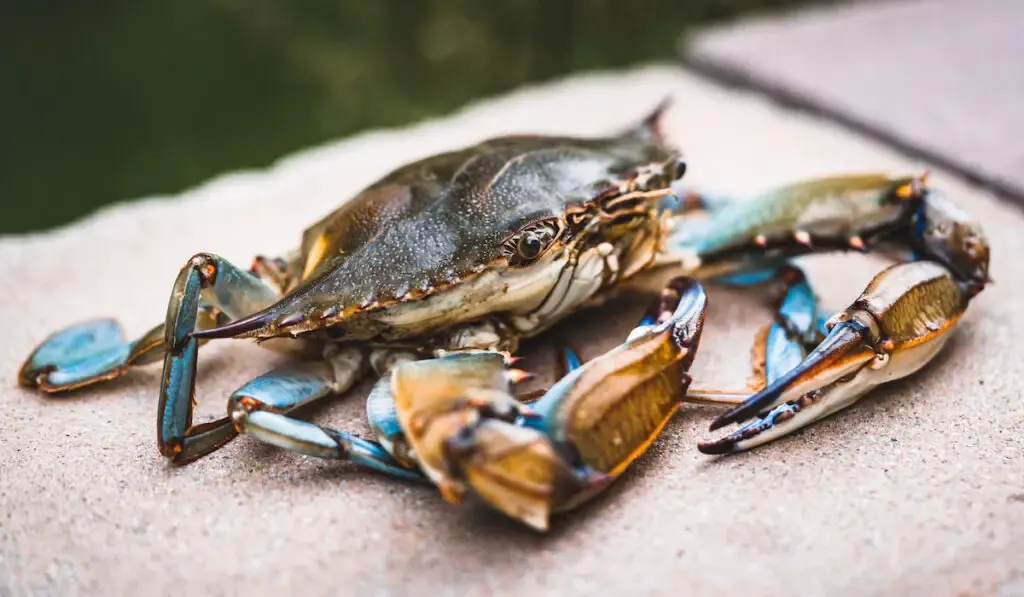
Also known as the Atlantic Blue Crab, these bottom-dwelling crustaceans can be found along the Atlantic and Gulf coasts from Nova Scotia through the Gulf of Mexico, and even in Uruguay.
They measure between 4 inches long and 9 inches wide and weigh around 1 to 2 pounds. The Chesapeake blue crabs possess sapphire-tinted claws and a bluish to olive green shell (carapace).
Fully matured female crabs can be recognized by red markings or highlights on the tips of their pincers.
These crabs live up to 3 years and feed mostly on mussels, oysters, clams, freshly dead fish, and other small crustaceans.
They are one of the most famous commercial and recreational catches in Chesapeake Bay.
4. Blue Tang Fish
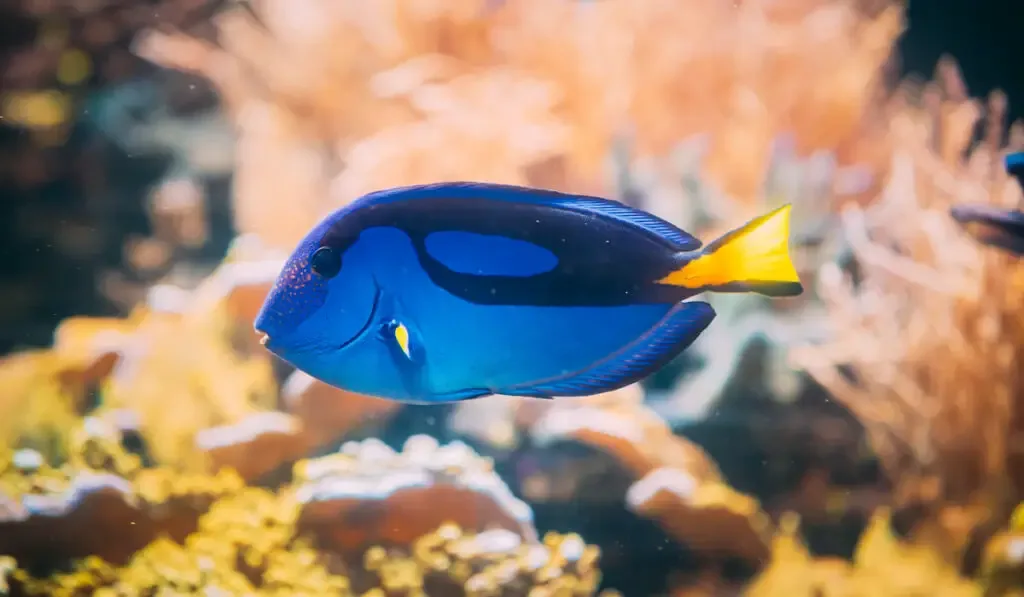
Blue Tangs can be found in clear waters, coral, and rocky reefs in the Indo-Pacific oceans.
These small fish measure between 4.7 and 9.84 inches and weigh around 1.6 pounds.
With their blue to purple ovoid body and yellow or white spine along their caudal peduncle, it is pretty easy to spot them from afar.
Blue Tangs live up to 20 years and mainly feed on marine plants and detritus. They are also called surgeonfish due to their scalpel-like spine on the side of their body.
The spines of their tail contain venom that protects them from predators. These fish are one of the popular collections for saltwater aquariums and aren’t suitable for human consumption.
People who eat blue tangs are prone to receive serious foodborne illnesses known as ciguatera poisoning.
This poisoning comes from a large number of dinoflagellates in blue tangs’ bodies that produce different kinds of toxins.
5. Cyanocitta Cristata
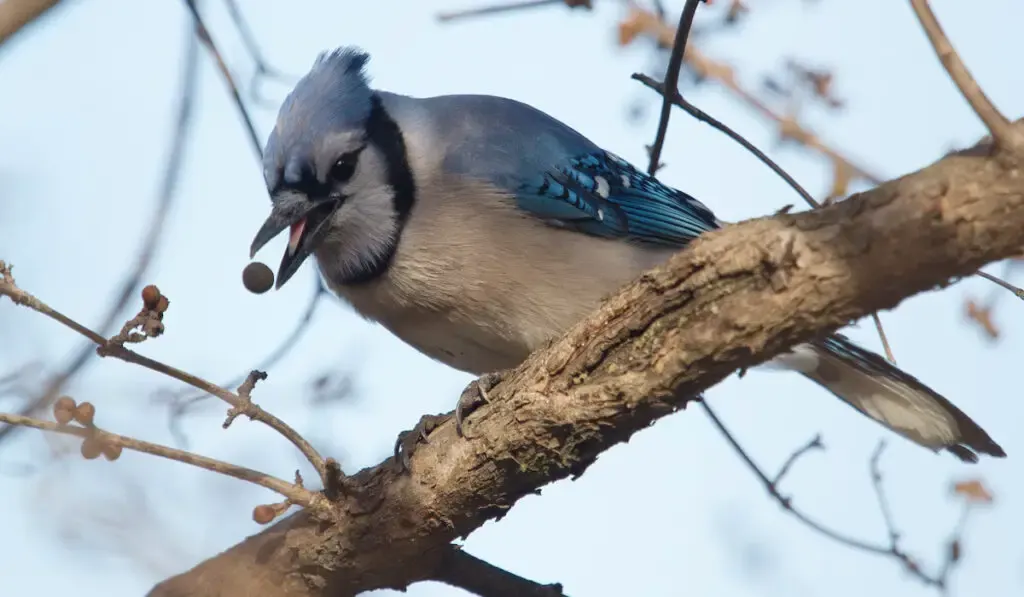
Commonly known as blue jays, these large songbirds are native to the Nearctic region and can be found mostly in Canada and in the east of the Rocky Mountains.
Blue jays can be easily spotted by their noisy calls. They possess bright blue coloration on their wings, tails, and top of their body, while their belly and chin are whitish gray. They have black bills, legs, eyes, and feet.
Blue jays are omnivorous birds. Their diet consists of seeds, grain, acorns, beechnuts, vegetables, fruits, insects, snails, frogs, and occasionally small rodents.
Female blue jays usually lay between three and six eggs at one time.
Their eggs are greenish and pale blue in color with random brown spots. The incubation period for the eggs is typically between 17 and 18 days.
6. Sinai Agama
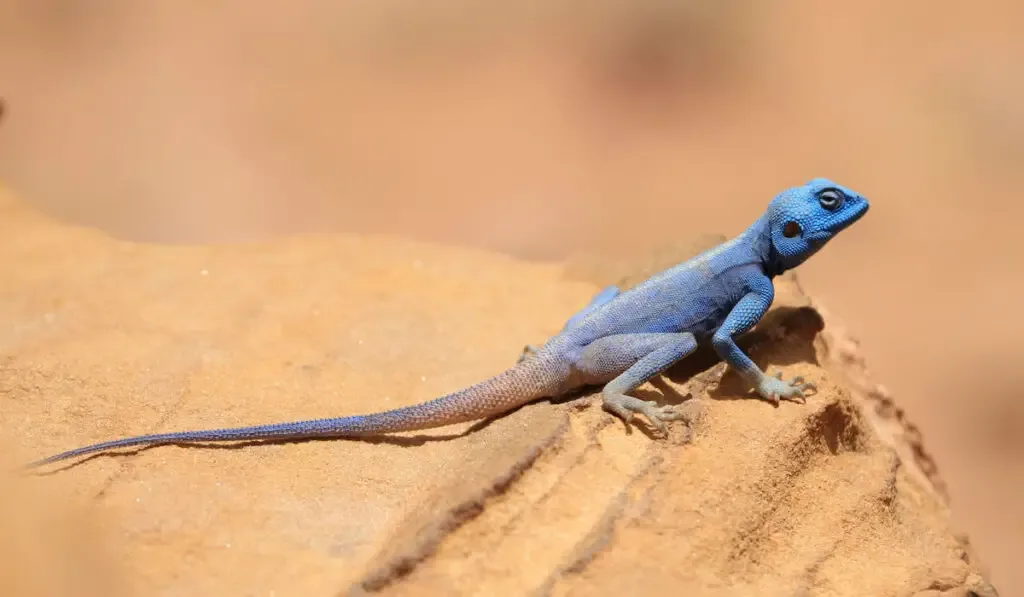
Sinai Agama, also known as Pseudotrapelus sinaitus, is an agamid lizard that can be found in arid areas of Southern Libya, Israel, Sudan, eastern Egypt, Saudi Arabia, and other Afrotropical regions.
Sinai Agamas are small lizards with slender bodies that are 3.94 inches in length.
They have long legs, triangle-shaped heads, and eyes that are situated closely at the top of their head.
In Arabic, they are called ‘qadi sina’, which means ‘the judge of sina’. This name derived from the high stance they take when they raise themselves on their limbs.
This natural act also keeps them away from the heat of the ground or rocks below them.
Being diurnal, they are active mostly during day time.
Sinai Agama’s skin turns bright blue during mating season to attract potential mates. But during the normal season, their skins are generally dull-brown color.
7. Indian Peafowl

The Indian peafowls are large birds that are native to Southern Asia.
Their natural habitats are mostly shrouded or broadleaved open forests. Also known as peacocks, the male Indian peafowls are well-known for their bright blue feathers and large ornamental tails.
On the other hand, the female Indian peafowls, known as peahens, are brown or cream in color and do not have large tails like the males.
Peafowls weigh between 6 and 13.2 pounds with a wingspan of 55 to 63 inches.
Being polygamous, male Indian peafowls mate with many peahens during their breeding season.
They show off their tails before mating in order to attract potential mating partners at ‘lek’ sites, which is the site that many peafowls gather to display their beautiful tails.
8. Common Blue Damselflies
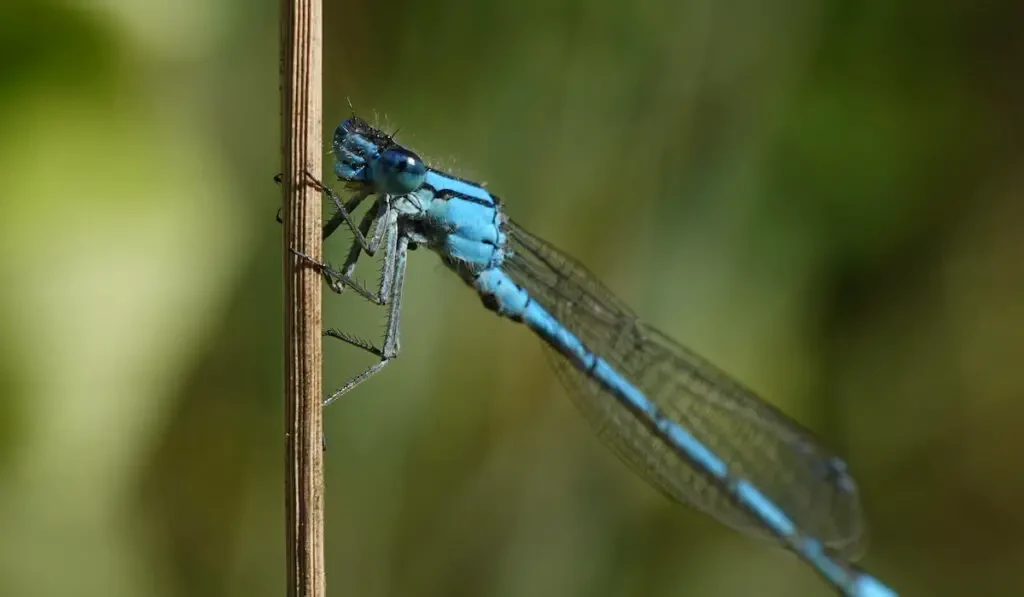
From afar, the common blue damselflies might look the same as the dragonflies but they are totally different.
Common blue damselflies have much thinner and slender bodies than dragonflies. They can be found in any place in the world except in the Arctic.
Male damselflies usually have blue bodies with black spots and button markings below their wings while females have blue or dull green bodies with black spots and thistle-shaped markings below their wings.
They grow up to 1.3 inches in length.
Common blue damselflies love to fly and scatter around the river, large lakes, ponds, canal banks and shaded woody areas.
They are carnivorous predators and prey on other smaller insects like mosquitoes, flies, midges, smaller dragonflies, and butterflies.
9. Hyacinth Macaw
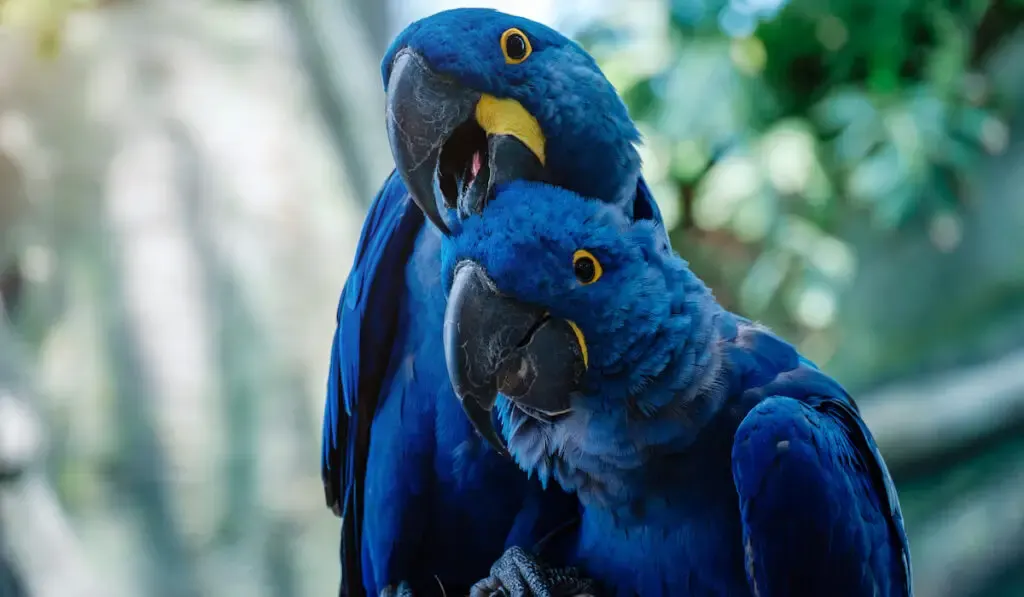
The largest breed of all parrots, these blue parrots can be found in Southern Brazil, Northeastern Paraguay, and Eastern Bolivia.
Hyacinth macaws grow up to 40 inches in length and weigh around 2.6 to 3.7 pounds.
They have cobalt-blue feathers with bright yellow rings around their eyes and beak. These birds live up to 50 years and help in spreading any seeds or nuts they feed on.
Hyacinth macaws’ natural habitats are mostly in woodlands, palm swamps, and slightly open forests.
They have a different range of sounds like deep guttural growls, high trills, and loud screeching. Most of the time, they feed on fruits, vegetables, different kinds of nuts, and also seeds.
10. Grand Cayman Iguana
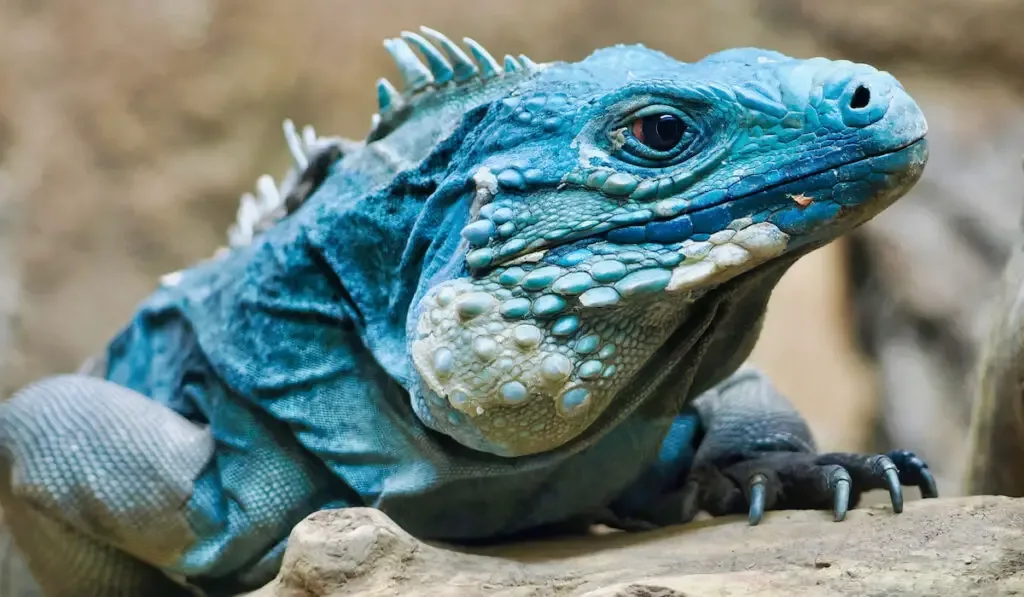
Also known as Cyclura lewisi, Grand Cayman Iguanas are ground-dwelling, blue reptiles that weigh around 25 pounds and measure over 59.1 inches from head to tail.
One of the largest lizards in Western Hemisphere, these extremely endangered species are endemic to the Island of Grand Cayman.
These blue iguanas are climbers and good at digging. The male iguanas are much larger than the females and their skin color ranges from dark grey to turquoise blue.
They have stiffed dorsal spines, a spineless dewlap, and golden eyes with red sclera.
With their sharp vision, they detect any movement clearly but in low-light conditions, they don’t see quite well.
Blue iguanas are herbivores and they mainly feed on leaves, flowers, and fruits.
11. Carpathian Blue Slug

These large, terrestrial pulmonate gastropods are considered endemic to the Carpathian Mountains in Eastern Europe.
Carpathian blue slugs were first discovered in 1847 and grow up to 5.5 inches in length. The adult slugs come in different shades of color ranging from dark and navy blue to bright turquoise.
But when they are young, their bodies are mostly in yellowish-brown color with dark lateral bands. They only have accessory organs for copulation and lay around 30 to 80 eggs at a time.
12. Mountain Bluebird
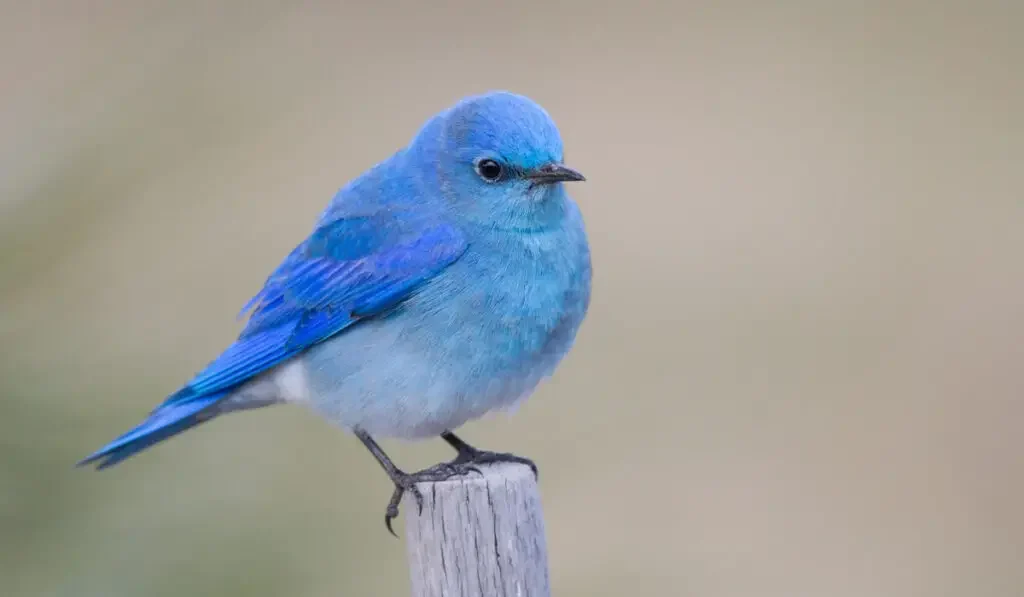
Mountain bluebirds can be found in Alaska, Canada, and more commonly in the West side of the United States.
Male mountain bluebirds possess bright turquoise blue feathers with a white underbelly while females possess gray feathers with blue wings, tails, and some shades of orange-brown on their chest.
Unlike other bluebirds, they have thin bills and longer wings.
These birds are omnivores. Their diet mainly consists of insects, fruits, seeds, and other edible plants.
Considered monogamous, male bluebirds only mate with one female bluebird at a time. Female bluebirds choose their potential mating partner based on a good nest site, not their physical qualities.
13. Common Kingfisher
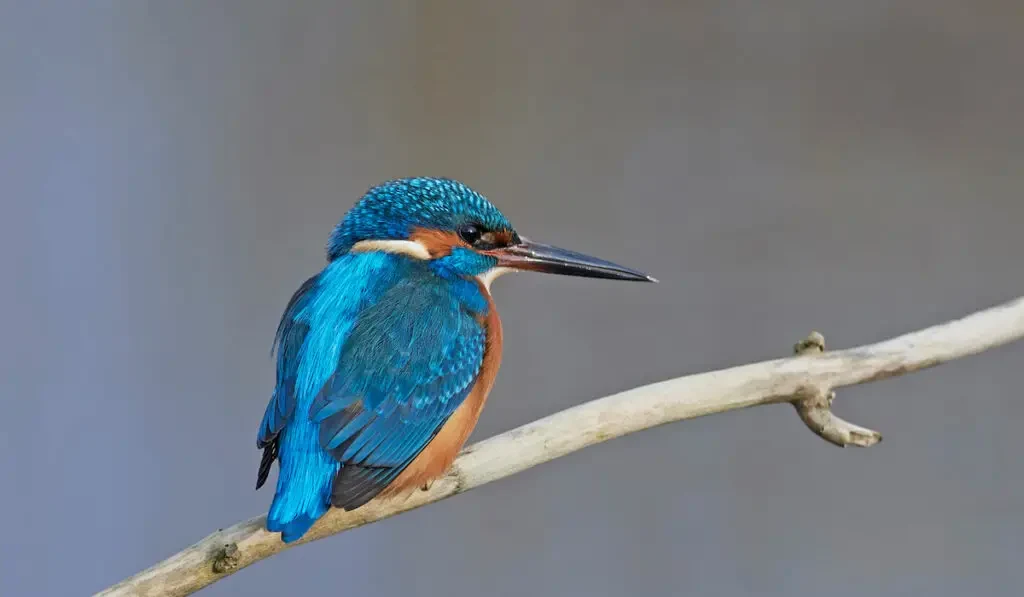
Common Kingfishers are also known by their other names like the European Kingfisher, the Eurasian Kingfisher, and the River Kingfisher.
These birds can be found in many places including Europe, North Africa, Italy, Western Cape South Africa, and Asia.
Common Kingfishers measure around 7.5 inches with a wingspan of 2.95 inches. Like other kingfishers, they possess a big head, short tail, and long black bill.
They also have bright blue and orange plumage, with chestnut underbelly and bright orange feet.
Their main habitats are clear, slow-flowing rivers, lakes, swamps, mangrove creeks, and shaded ponds.
Common Kingfishers’ diet consists of fish, crustaceans, aquatic insects, and freshwater shrimps. They always perch in tree branches that are close to shallow water to hunt for their food.
14. Blue Dacnis
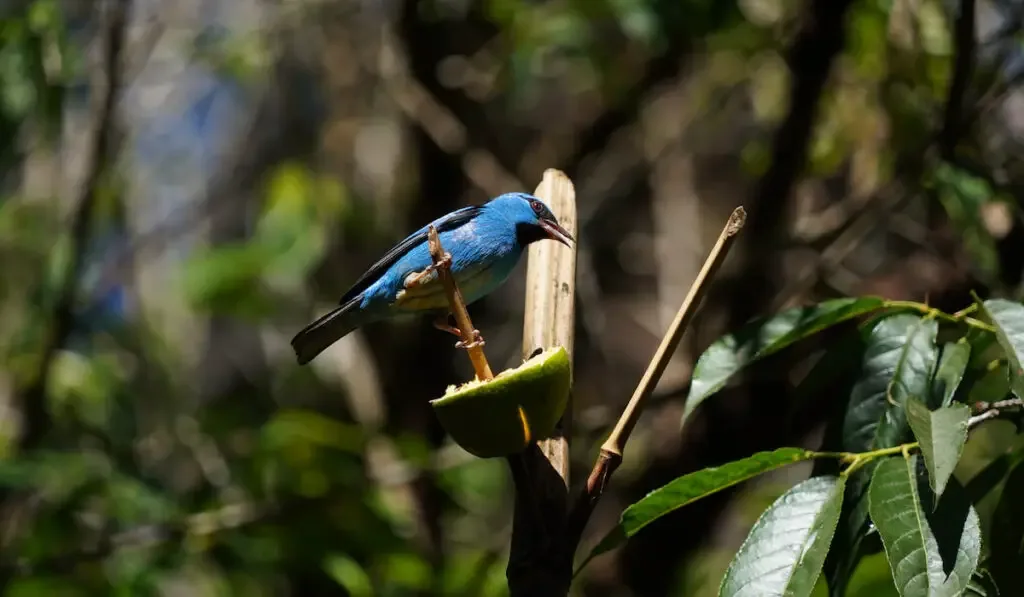
Also known as Dacnis cayanas or Turquoise Honeycreepers, these small passerine birds can be found in many places like Trinidad, Bolivia, northern Argentina, Nicaragua, Panama, as well as in the South America range.
Male Dacnis birds possess a bright blue or turquoise body with a black tail, shoulder, wing-bars, throat, and shoulders while females can be recognized by their striking shades of green on their body and blue head.
These birds measure around 5 inches and weigh around 0.03 pounds. Blue Dacnis birds are commonly seen in pairs or small groups.
They will occupy the canopy of lowland, foothill forests, edges, as well as fields with sparse trees.
These birds mainly feed on insects, fruits, seeds, and nectars.
They mate in the summer and spring. Female Dacnis lay between 2 and 3 whitish-green eggs in their nest that is placed around 16 to 23 feet above the ground.
15. Blue Morpho Butterfly
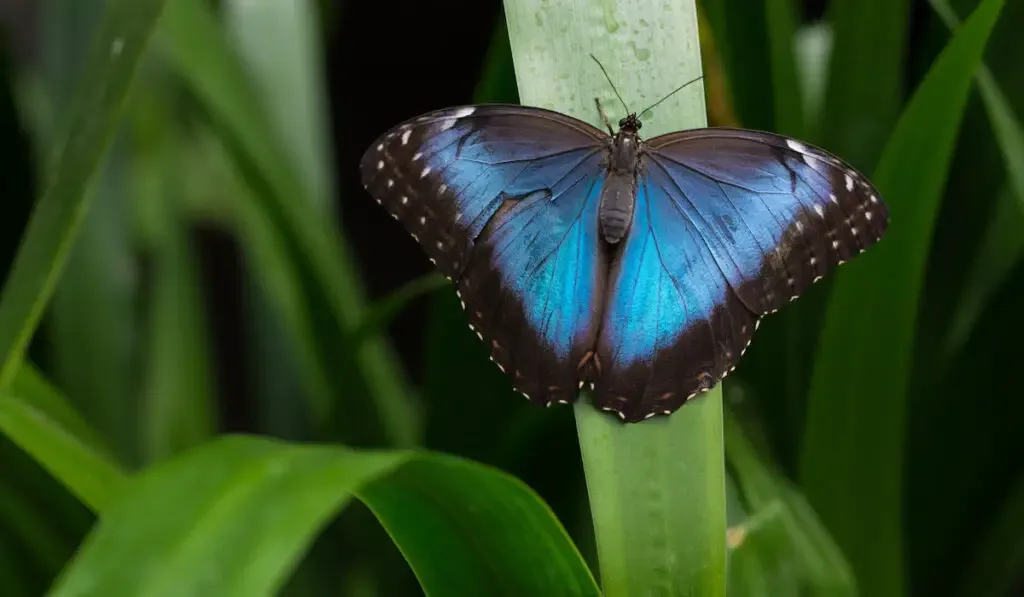
Considered as one of the largest butterflies in the world, blue morpho butterflies (Morpho peleides) mostly inhabit tropical and lowland forests in Central and South America.
But they can also be found flying in open areas like forest edges, trails, and along rivers.
One of their unique physical features is the iridescent blue color found on the top side of their wings and cryptic coloration on the undersides of the wings.
They have clubbed antennas and their wingspan measures between five and eight inches, which is twice as large as other ordinary butterflies.
Adult Blue morphos are considered frugivores, which means that they mostly feed on fruits or decaying fruits.
They don’t feed on nectars like other butterflies. But occasionally, when there are no decaying fruits around, they will feed on the tree sap of Samanea trees.
16. Hypselodoris Infucata
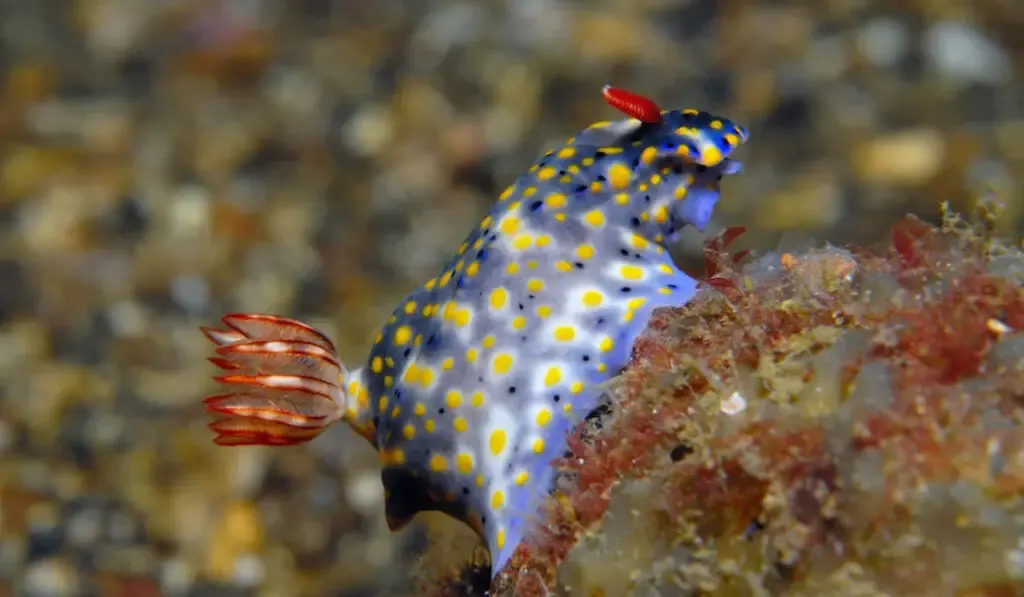
These blue slugs can be found widely distributed throughout the tropical Indo-Pacific and Mediterranean seas.
Hypselodoric infucatas commonly inhabit the intertidal and shallow subtidal regions on tropical reefs. They grow up to 2.17 inches in length.
They possess a dark blue body with a unique and complex color pattern which often resembles white or yellow pigmentations found all over their body. Some irregular black spots can also be found on top of these pigmentations.
These blue slugs are carnivorous and mainly feed on sponges. Hypselodoris Infucatas are hermaphrodites.
When they reproduce, their eggs are deposited on a substratum before developing, hatch into planktonic larvae and finally grow into adults.
17. Humphead Wrasse
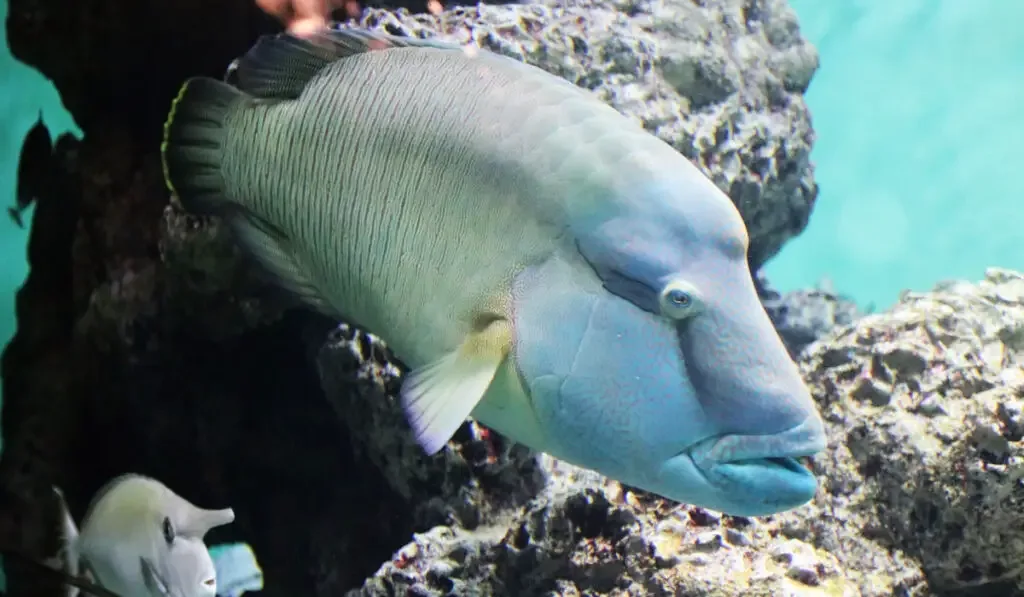
Humphead wrasses are large reef fish that grow up to seven feet and weigh around 420 pounds. They are also known as the Maoris, Napolean Wrasses, and Cheilinus undulatus.
These endangered fish are found throughout the Indo-Pacific oceans, from the coast of East Africa to the central Pacific, from south Japan to Melanesia, as well as in the U.S. Pacific regions.
The wrasses possess thick, full lips, and a forehump head that grows larger when they mature.
Male wrasses come in different colors ranging from bright blue, purplish, green, to dull greenish-blue while females mostly come in red-orange color.
They live up to 30 years and roam through coral reefs to feed on hard-shelled mollusks, crustaceans, and starfish.
18. Linckia Laevigata
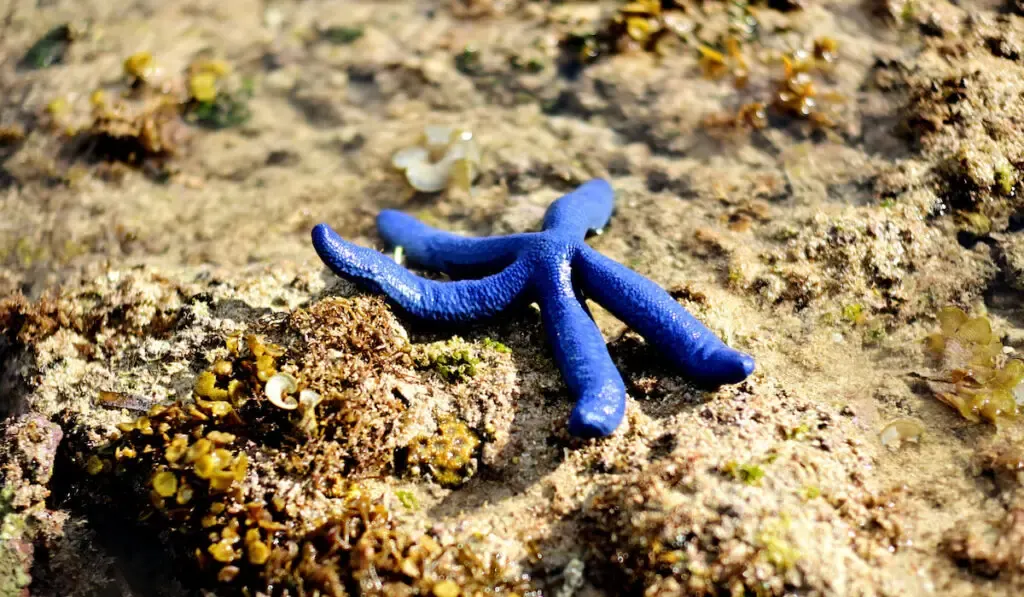
These blue starfishes are widely distributed in the Indo-Pacific oceans.
Linckia laevigatas inhabit shallow reef areas that are exposed to sunlight, on rocks, dead corals, and rubbles at 0 to 196 feet depth.
They can be characterized by a bright blue body, five cylindrical arms, and yellow tube feet.
Most of the blue pigments in their skin are called linckiacyanin with some accessory yellow carotenoids present randomly.
Their diet consists of small invertebrates, detritus, and dead animals.
They can be both sexual and asexual. When they asexually reproduce, they will detach one arm away from the central disc. This detached arm will grow into another body with 4 cylindrical arms.
But when they sexually reproduce, they will go to through a gonochoric process, producing tiny embryos that will hatch into planktonic larvae, before transforming into pentamerous juveniles and grow up to be fully grown starfish.
19. Blue Glaucus

Blue glaucus (Glaucus Atlanticus) are small-sized, blue sea slugs that can be found throughout the Pacific, Atlantic, and Indian Oceans.
They are also known by their other names like the blue dragon, blue angel, and sea swallow.
The Glaucuses measure around 1.18 inches in length with pale blue ventral bands and silverish gray markings on the dorsal side.
They have dark stripes on their head, slender body, and six finger-like appendages.
Like other nudibranchs, they absorb toxins and stinging cells from their prey into their skin, instantaneously protecting them from predators and toxic prey.
They are considered carnivores and feed on larger pelagic organisms like common purple snails, blue snails, and venomous Portuguese Man O’War (Physalia physalis) which is a type of ocean drifter that resembles jellyfish.
20. Ulysses Butterfly
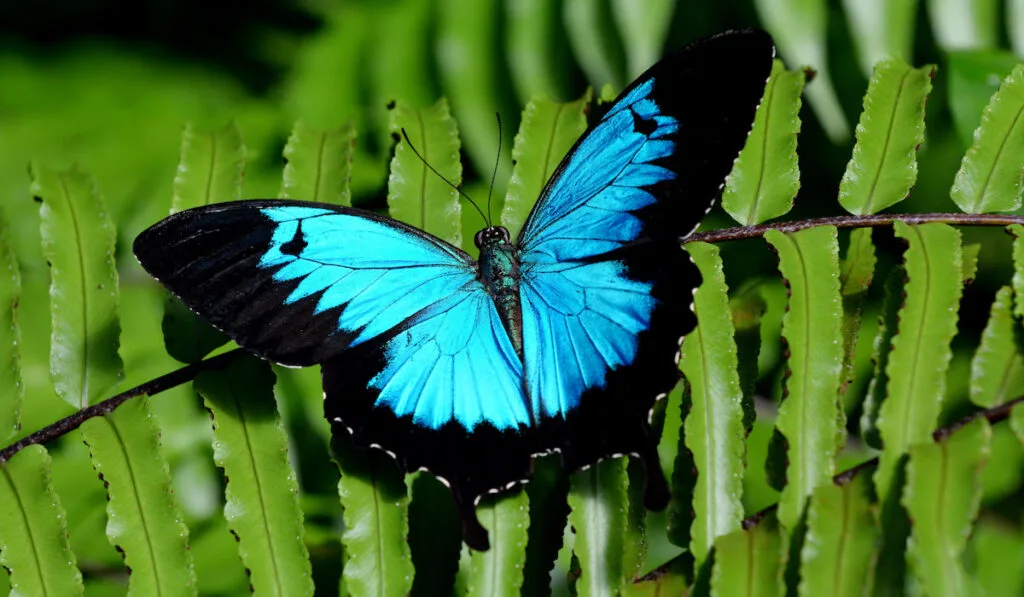
Also known as Papillo Ulysses or the Blue Emperor, Ulysses butterflies are large swallowtail butterflies that can be found in many regions such as Australia, Papua New Guinea, Indonesia, and the Solomon Islands.
They have a wingspan that could reach up to 5.5 inches.
The microscopic structure of their scales or structural coloration provides the upper side of their wings with iridescent electric blue color and blackish-brown color is found on the underside of the wings.
Meanwhile, the Ulysses caterpillars are green and white.
These colors serve as camouflage that protects them from predators.
Ulysses butterflies mainly feed on native or red and pink plants like the Ixora, Halfordia kendack, and Geijera species.
21. Bluestripe Garter Snake
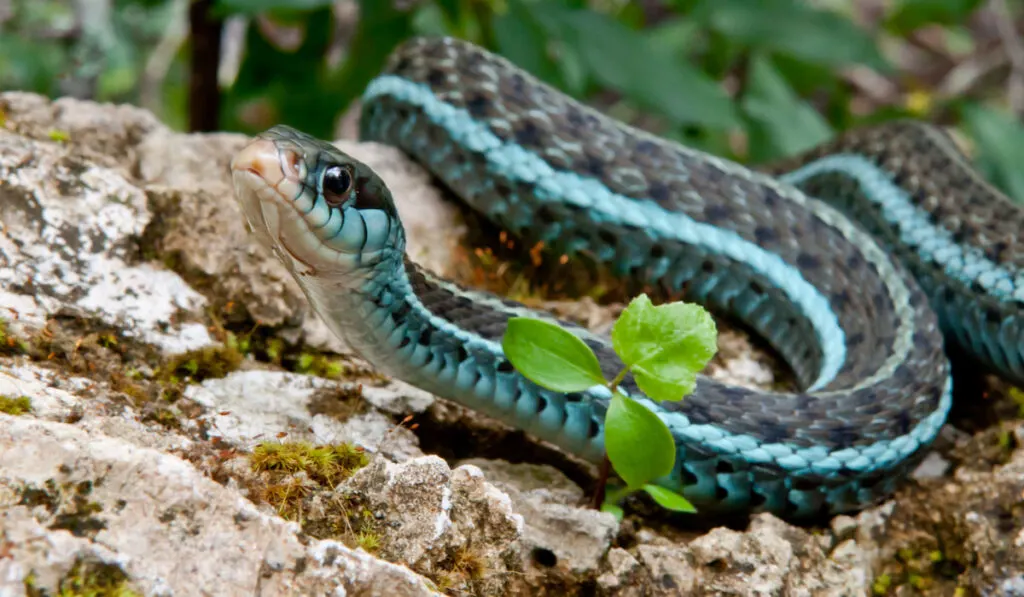
Bluestripe garter snakes (Thamnophis sirtalis) are natricine snakes that can be found widely across North America.
They go by other names; eastern garter snake, common garter snake, and the Garter. Adult garter snakes measure between 18 to 26 inches and weigh around 0.33 pounds.
They have a slender blue, brown, black, or green body with thin light yellow or blue stripes.
These garter snakes are non-venomous. But their bite might are harmful and could cause some serious pain. They are generally not aggressive and avoid direct contact with humans and animals.
Being diurnal, they are most active during the daytime. They feed mostly on frogs, small lizards, salamanders, earthworms, and freshwater fishes.
22. Mandarin Dragonet
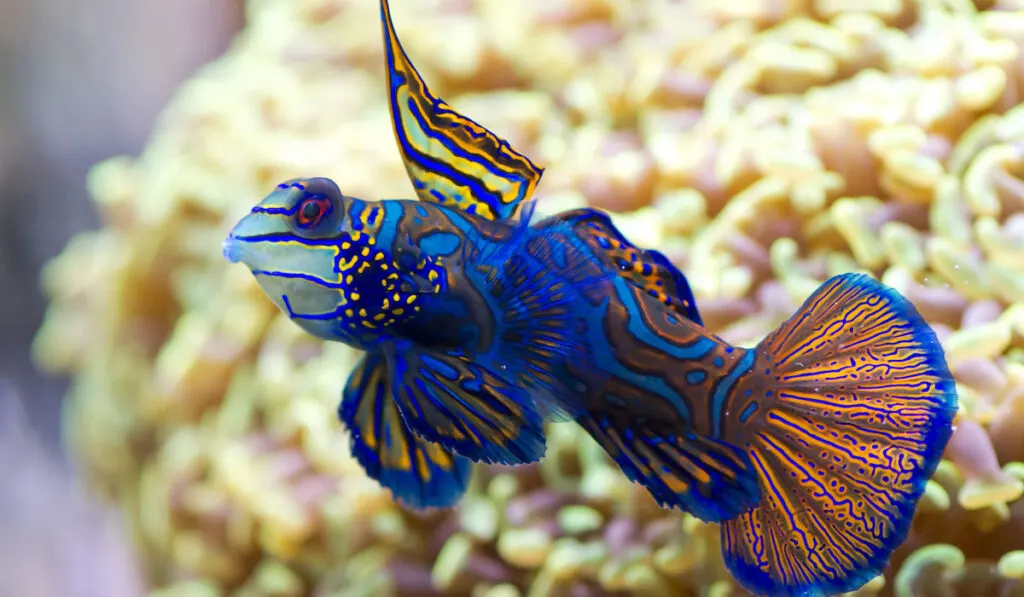
Mandarin dragonets are native to the Pacific, especially from the Ryukyu Islands to Australia.
Nowadays, they can be bought worldwide for a price of $20 to $40 as one of the species that are suitable for a reef-type tank.
Mandarin dragonets usually could only grow up to 3 inches.
They have bright to dark blue bodies, large eyes, yellow spots on their head, and orange markings on their tail. With their large pelvic fins, they move swiftly across the substrate.
These solitary creatures inhabit reefs and lagoons and feed on small invertebrates and crustaceans.
They secrete toxic mucus to protect themselves from potential predators.
23. Steelblue Ladybird
These cute harmless beetles are native to Australia. Also known as Halmus chalybeus, they were first introduced to New Zealand in 1899 and 1905 to control the blue gum scale and black scale on citrus trees.
Steelblue ladybirds measure around 0.1 to 0.2 inches in length.
They possess a distinctive dark metallic color on their rounded body.
They feed on many scale pests like red scale, cottony cushion scale, wax scale, psyllids, whiteflies, free-living gall mites, and other smaller insects like aphids and mealybugs.
The female ladybirds lay yellow eggs before they hatch into larvae that grow through four stages to become adult ladybirds.
Both adult and larval stages of steelblue ladybirds possess three pairs of legs.
24. Eurasian Blue Tit

Eurasian Blue Tits are small birds that can be found throughout Europe.
They commonly inhabit woody forests, gardens, parks, and hedges in farmlands.
Blue Tits measure around 4.72 inches long, with a wingspan of 7.09 inches, and weigh around 0.36 ounces.
They have a blue nape, yellow underparts, blue crown, white face with dark lines through their eyes, and a dull green back. They also have short dark bills and grey legs.
These birds feed on fruits, seeds, small insects, and young buds of various trees.
In winter, the Blue Tits will flock together and sometimes fly together with other birds to search for food.
25. Blue Dasher

Blue dashers are one of the most common dragonflies in the United States. But they are native to southern Canada, Mexico, Cuba, Bahamas, and Belize.
These dragonflies measure around 1.75 inches long and possess different colors on their body like blue, yellow, green, and black.
The male blue dashers are quite different from females. Males usually have bright blue color with black tips, yellow tiger-striped thoraces, and green or blue eyes above their white face.
On the other hand, the female blue dashers are slightly dull in color with brown and yellow-striped thoraces.
Blue Dashers inhabit the still water of ponds, lakes, and slow-moving streams.
They feed on other flying insects and can eat more than 30 mosquitoes per day.
Final Thoughts
Blue animals are definitely a gift to our world.
This is because they can’t voluntarily produce blue pigments like some blue plants that have anthocyanins in their cells.
So, the color that these animals have is biologically embedded in their genetic makeup. This factor alone makes them unique and different than any other animals.
Resources
Blue Poison Dart Frog
- https://livingrainforest.org/learning-resources/blue-poison-dart-frog
- https://rosamondgiffordzoo.org/experience/animals/amphibians/blue-poison-dart-frog/
- https://cosleyzoo.org/blue-poison-dart-frog/
Blue Whale
- https://oceana.org/marine-life/marine-mammals/blue-whale
- https://www.fisheries.noaa.gov/species/blue-whale
- https://www.worldwildlife.org/species/blue-whale
Chesapeake Blue Crab
- https://www.chesapeakebay.net/discover/field-guide/entry/blue_crab
- https://www.nationalgeographic.com/animals/invertebrates/facts/blue-crab
- https://www.nwf.org/Educational-Resources/Wildlife-Guide/Invertebrates/Blue-Crab
Blue Tang Fish
- https://seaworld.org/animals/facts/bony-fish/blue-tang/
- https://www.nationalgeographic.com/animals/fish/facts/blue-tang
- https://oceana.org/marine-life/ocean-fishes/blue-tang
Cyanocitta Cristata
- https://www.audubon.org/field-guide/bird/blue-jay
- https://animaldiversity.org/accounts/Cyanocitta_cristata/
- https://www.allaboutbirds.org/guide/Blue_Jay/overview#
Sinai Agama
- https://inaturalist.ca/taxa/31515-Pseudotrapelus-sinaitus
- https://wanderingthroughwadis.com/2019/03/17/sinai-agama/
- https://eol.org/pages/790879
Indian Peafowl
- https://seaworld.org/animals/facts/birds/indian-peafowl/
- https://animaldiversity.org/accounts/Pavo_cristatus/
- https://planetzoo.fandom.com/wiki/Indian_Peafowl
Common Blue Damselflies
- https://british-dragonflies.org.uk/species/common-blue-damselfly/
- https://owlcation.com/stem/the-common-blue-damselfly
- https://www.wildlifetrusts.org/wildlife-explorer/invertebrates/damselflies/common-blue-damselfly
Hyacinth Macaw
- https://lafeber.com/pet-birds/species/hyacinth-macaw/
- https://www.thesprucepets.com/hyacinth-macaws-390508
- https://wildfor.life/species/hyacinth-macaw
Grand Cayman Iguana
- https://carnivora.net/blue-grand-cayman-iguana-cyclura-lewisi-t1604.html
- https://animaldiversity.org/accounts/Cyclura_nubila_lewisi/
- https://reptile-database.reptarium.cz/species?genus=Cyclura&species=lewisi
Carphatian Blue Slug
- http://portugal.inaturalist.org/taxa/467115-Bielzia-coerulans
- https://eol.org/pages/40043392
- https://featuredcreature.com/carpathian-blue-slugs-prove-blue-slugs-are-the-best-slugs/
Mountain Bluebird
- https://www.allaboutbirds.org/guide/Mountain_Bluebird/overview
- https://ebird.org/species/moublu
- https://animalia.bio/mountain-bluebird
Common Kingfisher
- http://datazone.birdlife.org/species/factsheet/common-kingfisher-alcedo-atthis
- https://www.beautyofbirds.com/commonkingfishers.html
- https://ebird.org/species/comkin1
Blue Dacnis
- https://dwazoo.com/animal/blue-dacnis/
- https://ebird.org/species/bludac1
- https://www.nativealimentos.com.br/en/sustainability/biodiversity/animals/birds/blue-dacnis/643
Blue Morpho Butterfly
- http://entnemdept.ufl.edu/creatures/bfly/blue_morpho.htm
- https://amazonaid.org/species/blue-morpho-butterfly/
- https://www.rainforest-alliance.org/species/blue-morpho-butterfly
Hypselodoris Infucata
- https://www.sealifebase.ca/summary/Hypselodoris-infucata.html
- http://www.seaslugforum.net/find/hypsinfu
- http://www.ciesm.org/atlas/Hypselodorisinfucata.html
Humphead Wrasse
- https://www.biologicaldiversity.org/species/fish/humphead_wrasse/natural_history.html
- https://www.iucn.org/commissions/ssc-groups/fishes/grouper-and-wrasse-specialist-group/humphead-wrasse
- https://www.worldwildlife.org/species/humphead-wrasse
Linckia Laevigata
- https://animaldiversity.org/accounts/Linckia_laevigata/
- https://www.sealifebase.ca/summary/Linckia-laevigata.html
- https://www.fishkeeper.co.uk/help-and-advice/marine/miscellaneous-invertebra
Blue Glaucus
- https://animals.fandom.com/wiki/Blue_Glaucus
- https://www.pbs.org/wnet/nature/blog/inside-nature-featured-creature-blue-dragon/
- https://oceana.org/marine-life/corals-and-other-invertebrates/blue-glaucus
Ulysses Butterfly
- https://australianbutterflies.com/the-ulysses-butterfly/
- https://www.wettropics.gov.au/beautiful-butterflies
- https://inaturalist.ca/taxa/67438-Papilio-ulysses
Bluestripe Garter Snake
- https://www.inaturalist.org/guide_taxa/1218327
- https://srelherp.uga.edu/jd/jdweb/Herps/species/USsnakes/thasirsim.htm
- https://www.floridamuseum.ufl.edu/florida-snake-id/snake/common-gartersnake/
Mandarin Dragonet
- https://www.fishkeepingworld.com/mandarin-fish/
- https://www.thesprucepets.com/mandarinfishes-dragonets-2925109
- https://www.calacademy.org/explore-science/mandarin-dragonet
Steelblue Ladybird
- https://www.homestolove.com.au/good-bug-steelblue-ladybird-9821
- https://www.inaturalist.org/taxa/244625-Halmus-chalybeus
- https://nzacfactsheets.landcareresearch.co.nz/factsheet/InterestingInsects/Steelblue-ladybird—Halmus-chalybeus.html
Eurasian Blue Tit
- https://birds.fandom.com/wiki/Eurasian_Blue_Tit
- https://ebird.org/species/blutit
- https://www.rspb.org.uk/birds-and-wildlife/wildlife-guides/bird-a-z/blue-tit/
Blue Dasher
